Spatial Distribution Characteristics and Influencing Factors of Cultivated Land Productivity in a Large City: Case Study of Chengdu, Sichuan, China
Abstract
1. Introduction
2. Materials and Methods
2.1. Study Area
2.2. Data Sources
2.3. Methods
2.3.1. CLP Evaluation Model
2.3.2. Spatial Autocorrelation Analysis
2.3.3. GeoDetectors
2.3.4. Limiting Factor Index Model
3. Results
3.1. Spatial Differentiation Characteristics of CLP
3.2. Spatial Autocorrelation Analysis of CLP
3.3. Driving Factor Analysis
3.4. Analysis of Limiting Factors of CLP
4. Discussion
4.1. Spatial Patterns and Influencing Factors
4.2. Degree of Restriction
4.3. Limitations and Prospects
5. Conclusions
Author Contributions
Funding
Data Availability Statement
Acknowledgments
Conflicts of Interest
References
- Ensieh Esmaeili, F.S.; Sarmadian, F.; Jafarzadeh, A.A.; Hayati, B. Impacts of cultivated land conversion on cultivated land productivity in China: Prediction and analysis. Chin. J. Appl. Ecol. 2010, 21, 3113–3119. [Google Scholar]
- Li, Y.; Wu, H.-x.; Shi, Z. Farmland productivity and its application in spatial zoning of agricultural production: A case study in Zhejiang province, China. Environ. Earth Sci. 2016, 75, 159. [Google Scholar] [CrossRef]
- Yao, C.; Teng, Y.; Huang, L. Evaluation index system construction and empirical analysis on food security in China. Trans. Chin. Soc. Agric. Eng. 2015, 31, 1–10. [Google Scholar]
- Lichtenberg, E.; Ding, C. Assessing farmland protection policy in China. Land Use Policy 2008, 25, 59–68. [Google Scholar] [CrossRef]
- He, J.; Liu, Y.; Yu, Y.; Tang, W.; Xiang, W.; Liu, D. A counterfactual scenario simulation approach for assessing the impact of farmland preservation policies on urban sprawl and food security in a major grain-producing area of China. Appl. Geogr. 2013, 37, 127–138. [Google Scholar] [CrossRef]
- Qianwen, C.; Penghui, J.; Lingyan, C.; Jinxia, S.; Yunqian, Z.; Liyan, W.; Manchun, L.; Feixue, L.; Axing, Z.; Dong, C. Delineation of a permanent basic farmland protection area around a city centre: Case study of Changzhou City, China. Land Use Policy 2017, 60, 73–89. [Google Scholar] [CrossRef]
- Zhao, C.; Zhou, Y.; Jiang, J.; Xiao, P.; Wu, H. Spatial characteristics of cultivated land quality accounting for ecological environmental condition: A case study in hilly area of northern Hubei province, China. Sci. Total Environ. 2021, 774, 145765. [Google Scholar] [CrossRef]
- Li, T.; Long, H.; Zhang, Y.; Tu, S.; Ge, D.; Li, Y.; Hu, B. Analysis of the spatial mismatch of grain production and farmland resources in China based on the potential crop rotation system. Land Use Policy 2017, 60, 26–36. [Google Scholar] [CrossRef]
- Hao, S.; Wang, G.; Yang, Y.; Zhao, S.; Huang, S.; Liu, L.; Zhang, H. Promoting grain production through high-standard farmland construction: Evidence in China. J. Integr. Agric. 2024, 23, 324–335. [Google Scholar] [CrossRef]
- Peng, J.; Zhao, Z.; Chen, L. The Impact of High-Standard Farmland Construction Policy on Rural Poverty in China. Land 2022, 11, 1578. [Google Scholar] [CrossRef]
- Zhao, Y.; Liu, X.; Ao, Y. Analysis of cultivated land change, pressure index and its prediction in Shaanxi province. Trans. Chin. Soc. Agric. Eng. (Trans. CSAE) 2013, 29, 217–223. [Google Scholar]
- Dedeoğlu, M.; Başayiğit, L.; Yüksel, M.; Kaya, F. Assessment of the vegetation indices on Sentinel-2A images for predicting the soil productivity potential in Bursa, Turkey. Environ. Monit. Assess. 2019, 192, 16. [Google Scholar] [CrossRef] [PubMed]
- Gu, Z.; Xie, Y.; Gao, Y.; Ren, X.; Cheng, C.; Wang, S. Quantitative assessment of soil productivity and predicted impacts of water erosion in the black soil region of northeastern China. Sci. Total Environ. 2018, 637–638, 706–716. [Google Scholar] [CrossRef]
- Sciortino, M.; De Felice, M.; De Cecco, L.; Borfecchia, F. Remote sensing for monitoring and mapping Land Productivity in Italy: A rapid assessment methodology. CATENA 2020, 188, 104375. [Google Scholar] [CrossRef]
- Xiao, L.; Yang, X.; Cai, H.; Zhang, D. Cultivated Land Changes and Agricultural Potential Productivity in Mainland China. Sustainability 2015, 7, 11893–11908. [Google Scholar] [CrossRef]
- Lazarus, W.; Headlee, W.; Zalesny, R. Impacts of Supplyshed-Level Differences in Productivity and Land Costs on the Economics of Hybrid Poplar Production in Minnesota, USA. BioEnergy Res. 2015, 8, 231–248. [Google Scholar] [CrossRef]
- Yang, J.; Huang, K.; Lee, C.; Chiu, C. Incorporating lost productivity calculation into delay analysis for construction projects. KSCE J. Civ. Eng. 2014, 18, 380–388. [Google Scholar] [CrossRef]
- Peng, J.; Wen, L.; Fu, L.; Yi, M. Total factor productivity of cultivated land use in China under environmental constraints: Temporal and spatial variations and their influencing factors. Environ. Sci. Pollut. Res. 2020, 27, 18443–18462. [Google Scholar] [CrossRef] [PubMed]
- Wu, F.; Mo, C.; Dai, X.; Li, H. Spatial Analysis of Cultivated Land Productivity, Site Condition and Cultivated Land Health at County Scale. Int. J. Environ. Res. Public Health 2022, 19, 12266. [Google Scholar] [CrossRef]
- Zhang, X.; Wu, K.; Yang, Q.; Li, X. Progress on Connotation and Evaluation Index System of Cultivated Land Healthy Productivity. Chin. J. Soil Sci. 2020, 51, 245–252. [Google Scholar]
- Zhao, C.; Zhou, Y.; Li, X.; Xiao, P.; Jiang, J. Assessment of Cultivated Land Productivity and Its Spatial Differentiation in Dongting Lake Region: A Case Study of Yuanjiang City, Hunan Province. Sustainability 2018, 10, 3616. [Google Scholar] [CrossRef]
- Zhang, Y.; Feng, X.; Ren, S.; You, X.; Yu, C. Evaluation index system of cultivated land quality and productivity: A case study of Binyang County, Guangxi. J. Agric. Resour. Environ. 2021, 38, 1039–1050. [Google Scholar]
- Tang, M.; Wang, Q.; Mei, S.; Ying, C.; Gao, Z.; Ma, Y.; Hu, H. Research on the Inversion Model of Cultivated Land Quality Using High-Resolution Remote Sensing Data. Agronomy 2023, 13, 2871. [Google Scholar] [CrossRef]
- Du, H.; Cui, J.; Ha, K.; Men, M. Evaluation and Influencing factors of cultivated land productivity in coastal plain area: A case study of Huanghua City, Hebei Province. J. Agric. Univ. Hebei 2019, 42, 16–22. (In Chinese) [Google Scholar]
- Zhu, X.; Wang, B.; Huang, K.; Cao, T. Analysis of spatial distribution and factors influencing productivity of cultivated land in Zhong lou District of Changzhou City, China. J. Agric. Resour. Environ. 2020, 37, 672–680. [Google Scholar]
- Wu, X.; Jin, X.; Han, B.; Xu, W.; Ren, J.; Sun, R.; Zhou, Y. Characteristics of cultivated land productivity change and potential during 2001–2017 in Sichuan Province, China. Trans. Chin. Soc. Agric. Eng. 2021, 37, 238–249. [Google Scholar]
- Chen, Y.; Han, B.; Jin, X.; Zhang, Y. Analysis of the cropland productivity change and the impact of land consolidation in the Yangtze River Economic Zone. Trans. Chin. Soc. Agric. Eng. 2023, 39, 182–193. [Google Scholar]
- Zhang, J.; Dong, Y.; Ye, Z. Calculation of county-level cultivated land productivity based on NPP index corrected by topography. Trans. Chin. Soc. Agric. Eng. 2020, 36, 227–234. [Google Scholar]
- Lai, Z.; Chen, M.; Liu, T. Changes in and prospects for cultivated land use since the reform and opening up in China. Land Use Policy 2020, 97, 104781. [Google Scholar] [CrossRef]
- Zhang, X.; Wang, Y.; Yuan, X.; Yang, Y. Regional land ecological security evaluation and ecological poverty alleviation practice: A case study of Yangxian County in Shaanxi Province, China. J. Geogr. Sci. 2022, 32, 682–700. [Google Scholar] [CrossRef]
- He, Z.; He, W.; Li, L.; Zhang, J.; Li, H. Analysis of factors influencing quality of newly increased cultivated land and grain productivity in arid highland area—Taking occupation complementary balance project as an example. J. Drain. Irrig. Mach. Eng. (JDIME) 2022, 40, 1151–1158, 1166. (In Chinese) [Google Scholar]
- Ye, S.; Ren, S.; Song, C.; Cheng, C.; Shen, S.; Yang, J.; Zhu, D. Spatial patterns of county-level cultivated land productive-capacity and its coordination with land-use intensity in mainland China. Agric. Ecosyst. Environ. 2022, 326, 107757. [Google Scholar] [CrossRef]
- Wang, Y.; Li, G.; Wang, S.; Zhang, Y.; Li, D.; Zhou, H.; Xu, S. A Comprehensive Evaluation of Benefit of High-Standard Farmland Development in China. Sustainability 2022, 14, 10361. [Google Scholar] [CrossRef]
- Li, Y.; Chang, C.; Wang, Z.; Li, T.; Li, J.; Zhao, G. Identification of Cultivated Land Quality Grade Using Fused Multi-Source Data and Multi-Temporal Crop Remote Sensing Information. Remote Sens. 2022, 14, 2109. [Google Scholar] [CrossRef]
- Jiang, G.; Zhang, R.; Ma, W.; Zhou, D.; Wang, X.; He, X. Cultivated land productivity potential improvement in land consolidation schemes in Shenyang, China: Assessment and policy implications. Land Use Policy 2017, 68, 80–88. [Google Scholar] [CrossRef]
- Wang, X.; Zhou, D.; Jiang, G.; Peng, C. How can the sustainable goal of cultivated land use in the Qinghai-Tibet Plateau be realized?—Based on a research framework of cultivated land use patterns. Front. Environ. Sci. 2023, 11, 1134136. [Google Scholar] [CrossRef]
- Wang, J.; Xu, C. Geodetector: Principle and prospective. Acta Geogr. Sin. 2017, 72, 116–134. [Google Scholar]
- Wang, J.; Hu, Y. Environmental health risk detection with GeogDetector. Environ. Model. Softw. 2012, 33, 114–115. [Google Scholar] [CrossRef]
- Cao, F.; Ge, Y.; Wang, J. Optimal discretization for geographical detectors-based risk assessment. GIScience Remote Sens. 2013, 50, 78–92. [Google Scholar] [CrossRef]
- Jiang, Y.; Gao, J.; Wu, S.; Jiao, K. Mediation effect as the component to ecosystem? Establishing the chain effect framework of ecosystem services across typical karst basin in China. CATENA 2023, 221, 106761. [Google Scholar] [CrossRef]
- Lin, Q.; Ou, G.; Wang, R.; Li, Y.; Zhao, Y.; Dong, Z. The Spatiotemporal Characteristics and Climatic Factors of COVID-19 in Wuhan, China. Sustainability 2021, 13, 8112. [Google Scholar] [CrossRef]
- Feng, M.Q.; Huang, P.; Pan, H.Y.; Xu, J. Study on potentials of cultivated land quality improvement based on combination of restricted factors-taking Shifang as an example. China J. Agric. Resour. Reg. Plan. 2019, 40, 126–133. [Google Scholar]
- Liang, Z.; Chen, S.; Yang, Y.; Zhao, R.; Shi, Z.; Viscarra Rossel, R.A. National digital soil map of organic matter in topsoil and its associated uncertainty in 1980’s China. Geoderma 2019, 335, 47–56. [Google Scholar] [CrossRef]
- Zhang, L.; Peng, W.; Zhang, J. Assessment of Land Ecological Security from 2000 to 2020 in the Chengdu Plain Region of China. Land 2023, 12, 1448. [Google Scholar] [CrossRef]
- Zhao, D.L.; He, S.S.; Yang, J.Y.; Zhang, C.; Li, P.S.; Du, Z.B. Qualitative potential calculation of arable land consolidation based on limiting factors and hot spot analysis. Trans. Chin. Soc. Agric. Mach. 2017, 48, 158–164. [Google Scholar]
- Duan, D.; Sun, X.; Liang, S.; Sun, J.; Fan, L.; Chen, H.; Xia, L.; Zhao, F.; Yang, W.; Yang, P. Spatiotemporal Patterns of Cultivated Land Quality Integrated with Multi-Source Remote Sensing: A Case Study of Guangzhou, China. Remote Sens. 2022, 14, 1250. [Google Scholar] [CrossRef]
- Binte Mostafiz, R.; Noguchi, R.; Ahamed, T. Agricultural Land Suitability Assessment Using Satellite Remote Sensing-Derived Soil-Vegetation Indices. Land 2021, 10, 223. [Google Scholar] [CrossRef]
- Zhang, F.; Wang, H.; Qin, T.; Rojas, R.; Qiu, L.; Yang, S.; Fang, Z.; Xue, S. Towards sustainable management of agricultural resources: A framework to assess the relationship between water, soil, economic factors, and grain production. J. Environ. Manag. 2023, 344, 118401. [Google Scholar] [CrossRef] [PubMed]
- Nabiollahi, K.; Taghizadeh-Mehrjardi, R.; Kerry, R.; Moradian, S. Assessment of soil quality indices for salt-affected agricultural land in Kurdistan Province, Iran. Ecol. Indic. 2017, 83, 482–494. [Google Scholar] [CrossRef]
- Xingwu, D.; Li, R.; Guangli, Z.; Jinming, H.; Haiyan, F. Soil productivity in the Yunnan province: Spatial distribution and sustainable utilization. Soil Tillage Res. 2015, 147, 10–19. [Google Scholar] [CrossRef]
- Dong, H.; Han, J.; Zhang, Y.; Chen, T.; Fan, H.; Wang, C. Research on influencing factors of cultivated land productivity of high-standard farmland projects in Hanzhong city of China—An empirical study based on PLS-SEM. Front. Sustain. Food Syst. 2023, 7, 1176426. [Google Scholar] [CrossRef]
- Huo, K.; Ruan, Y.; Fan, H.; Guo, C.; Cai, H. Spatial-temporal variation characteristics of cultivated land and controlling factors in the Yangtze River Delta region of China. Front. Environ. Sci. 2022, 10, 871482. [Google Scholar] [CrossRef]

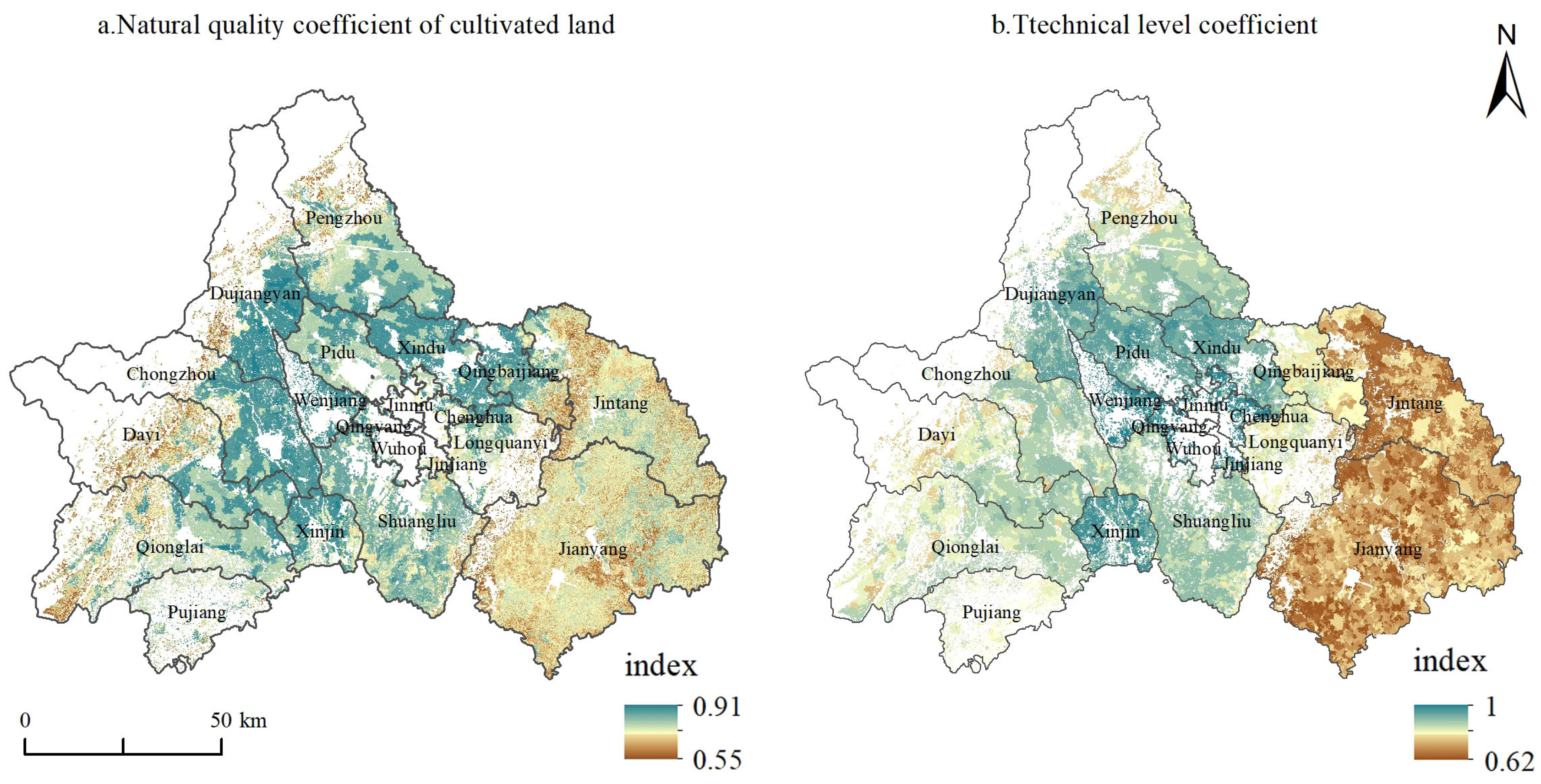
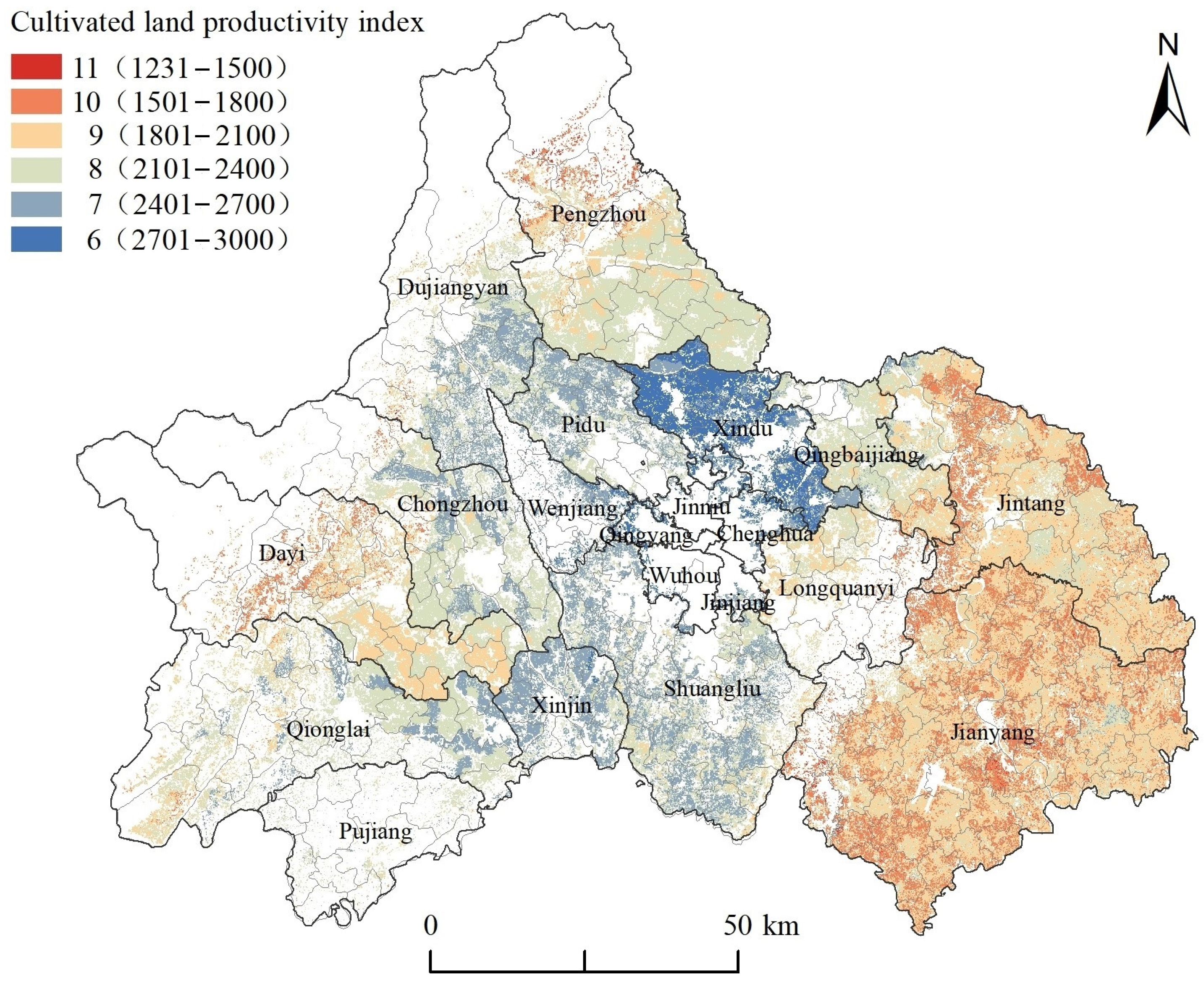
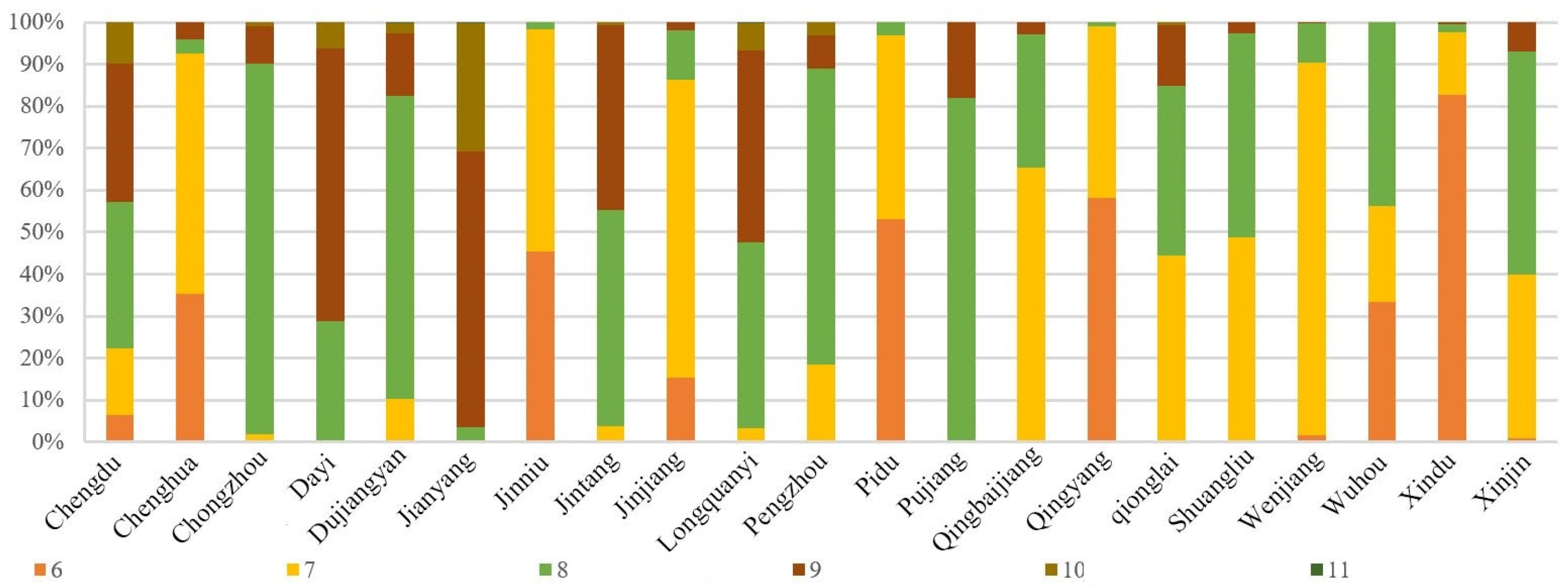
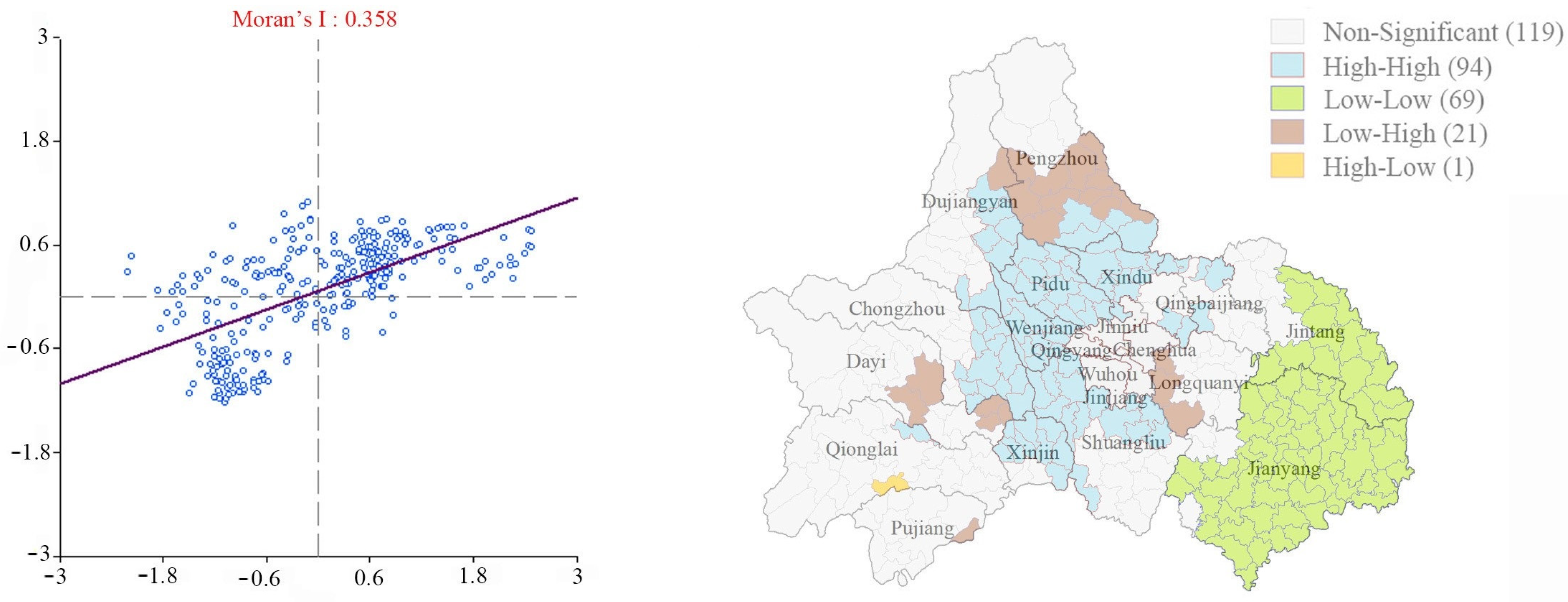
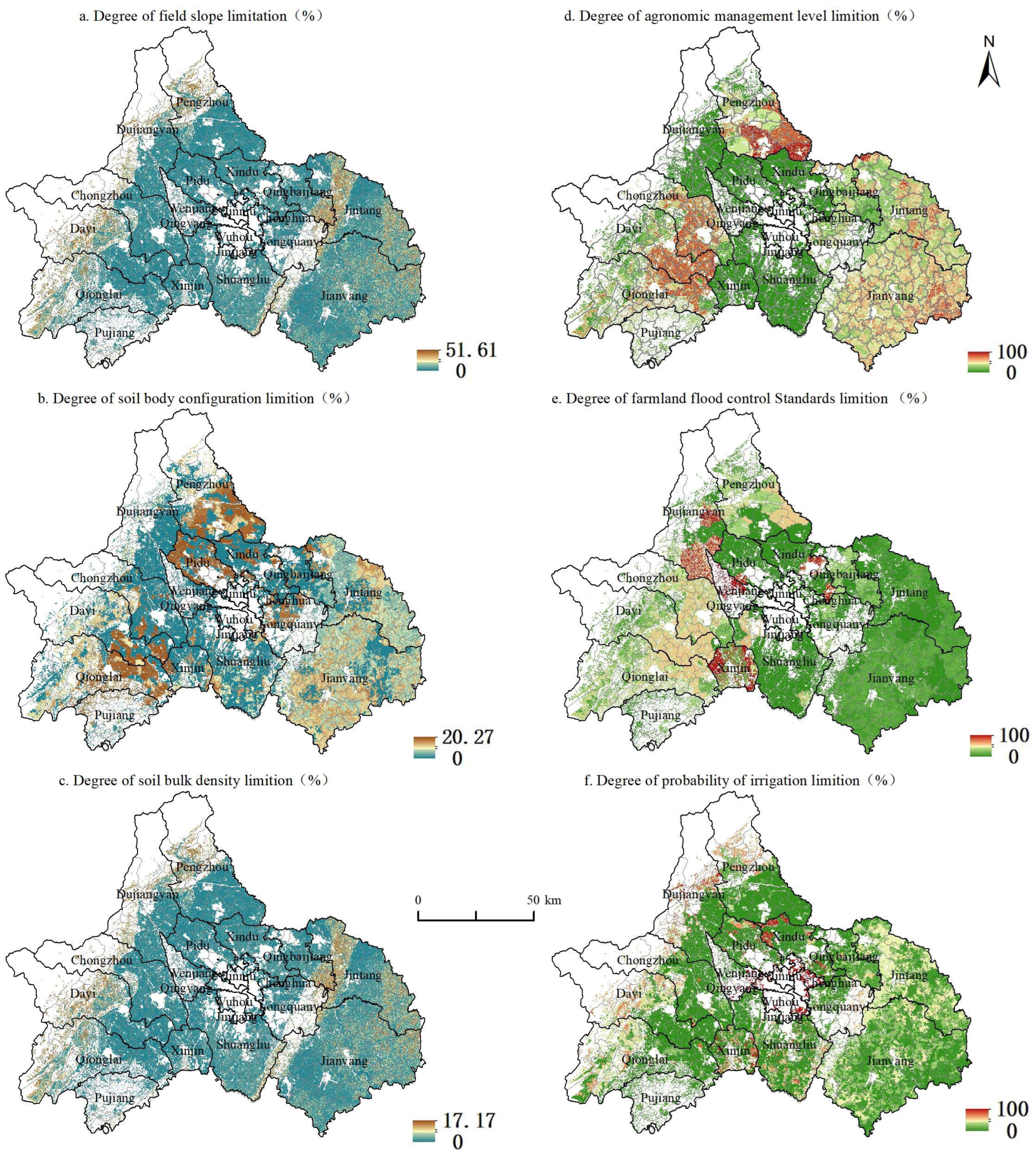
| Data Type | Name | Source |
|---|---|---|
| Topographic data | DEM | https://www.gscloud.cn/ accessed on 5 April 2023 |
| Field slope | ||
| Cultivated land quality data | Organic matter content | https://www.fao.org/soils-portal/soil-survey/soil-maps-and-databases/harmonized-world-soil-database-v12/en/, accessed on 6 May 2023 |
| Surface soil texture | ||
| PH | ||
| Soil nutrient element | ||
| Topographic position | Cultivated land quality is derived from the 2020 Land Use Change Survey database, Chengdu cultivated land quality and other annual update evaluation database, http://www.geodata.cn/ accessed on 6 May 2023 | |
| soil body configuration | ||
| Soil bulk density | ||
| Rural economy data | Agricultural mechanization level | Chengdu Statistical Yearbook, Chengdu Rural Statistical Yearbook, Chengdu natural disaster comprehensive risk survey results |
| Agricultural disaster prevention level | ||
| Agronomic management level | ||
| Irrigation guarantee rate | ||
| Farmland flood control standard |
| Serial Number | Primary Index | Secondary Index | Weight |
|---|---|---|---|
| 1 | Climatic conditions | Light–temperature potential productivity | - |
| 2 | Coefficient of crop yield ratio | - | |
| 3 | Natural quality of cultivated land | Topographic position | 0.13 |
| 4 | Field slope | 0.16 | |
| 5 | Effective soil layer thickness | 0.05 | |
| 6 | Organic content | 0.15 | |
| 7 | Surface soil texture | 0.14 | |
| 8 | Surface rock outcrop degree | 0.02 | |
| 9 | soil body configuration | 0.06 | |
| 10 | Soil bulk density | 0.04 | |
| 11 | Soil nutrient element | 0.15 | |
| 12 | PH | 0.1 | |
| 13 | Technical level | Irrigation guarantee rate | 0.17 |
| 14 | Drainage condition | 0.18 | |
| 15 | Farmland flood control standard | 0.18 | |
| 16 | Disaster prevention level | 0.19 | |
| 17 | Agricultural mechanization level | 0.16 | |
| 18 | Agronomic management level | 0.12 |
| Grade | CLPI | Grade | CLPI | Grade | CLPI |
|---|---|---|---|---|---|
| 1 | [4200, 4500] | 6 | [2700, 3000) | 11 | [1200, 1500) |
| 2 | [3900, 4200) | 7 | [2400, 2700) | 12 | [900, 1200) |
| 3 | [3600, 3900) | 8 | [2100, 2400) | 13 | [600, 900) |
| 4 | [3300, 3600) | 9 | [1800, 2100) | 14 | [300, 600) |
| 5 | [3000, 3300) | 10 | [1500, 1800) | 15 | [0, 300) |
| Primary Classification | Secondary Classification | Factor | Id | Q | p |
|---|---|---|---|---|---|
| Natural quality of cultivated land | Topographic condition | Field slope | X1 | 0.29 | <0.01 |
| Topographic position | X2 | 0.07 | <0.01 | ||
| Soil fertility | Organic content | X3 | 0.003 | >0.1 | |
| Soil nutrient element | X4 | 0.013 | >0.1 | ||
| PH | X5 | 0.13 | <0.01 | ||
| Soil bulk density | X6 | 0.43 | <0.01 | ||
| Physical structure | Surface soil texture | X7 | 0.10 | <0.01 | |
| Effective soil layer thickness | X8 | 0.19 | <0.01 | ||
| soil body configuration | X9 | 0.30 | <0.01 | ||
| surface rock outcrop degree | X10 | 0.19 | <0.01 | ||
| Technical level | Irrigation and drainage condition | Drainage condition | X11 | 0.15 | <0.01 |
| Irrigation guarantee rate | X12 | 0.30 | <0.01 | ||
| Technical management | Agronomic management level | X13 | 0.56 | <0.01 | |
| Agricultural mechanization level | X14 | 0.25 | <0.01 | ||
| Disaster prevention and reduction | Disaster prevention level | X15 | 0.09 | <0.01 | |
| Farmland flood control standard | X16 | 0.12 | <0.01 |
| Id | Natural Quality of Cultivated Land | Technical Level | ||||||||||||||
|---|---|---|---|---|---|---|---|---|---|---|---|---|---|---|---|---|
| Topographic Condition | Soil Fertility | Physical Structure | Irrigation and Drainage Condition | Technical Management | Disaster Prevention and Reduction | |||||||||||
| X1 | X2 | X3 | X4 | X5 | X6 | X7 | X8 | X9 | X10 | X11 | X12 | X13 | X14 | X15 | X16 | |
| X1 | 0.29 | |||||||||||||||
| X2 | 0.3 | 0.07 | ||||||||||||||
| X3 | 0.29 | 0.07 | 0.00 | |||||||||||||
| X4 | 0.30 | 0.08 | 0.02 | 0.01 | ||||||||||||
| X5 | 0.36 | 0.19 | 0.14 | 0.15 | 0.13 | |||||||||||
| X6 | 0.53 | 0.46 | 0.44 | 0.44 | 0.45 | 0.43 | ||||||||||
| X7 | 0.40 | 0.19 | 0.11 | 0.12 | 0.32 | 0.51 | 0.10 | |||||||||
| X8 | 0.38 | 0.22 | 0.19 | 0.19 | 0.23 | 0.49 | 0.35 | 0.19 | ||||||||
| X9 | 0.49 | 0.34 | 0.30 | 0.31 | 0.41 | 0.55 | 0.30 | 0.41 | 0.30 | |||||||
| X10 | 0.40 | 0.24 | 0.19 | 0.20 | 0.24 | 0.46 | 0.34 | 0.24 | 0.40 | 0.19 | ||||||
| X11 | 0.37 | 0.21 | 0.16 | 0.16 | 0.29 | 0.46 | 0.25 | 0.37 | 0.42 | 0.32 | 0.15 | |||||
| X12 | 0.44 | 0.32 | 0.31 | 0.31 | 0.33 | 0.52 | 0.44 | 0.32 | 0.47 | 0.32 | 0.43 | 0.30 | ||||
| X13 | 0.66 | 0.59 | 0.56 | 0.56 | 0.60 | 0.59 | 0.61 | 0.62 | 0.62 | 0.57 | 0.58 | 0.65 | 0.56 | |||
| X14 | 0.42 | 0.31 | 0.26 | 0.26 | 0.30 | 0.44 | 0.36 | 0.35 | 0.43 | 0.31 | 0.31 | 0.41 | 0.58 | 0.25 | ||
| X15 | 0.35 | 0.16 | 0.10 | 0.11 | 0.22 | 0.46 | 0.19 | 0.26 | 0.35 | 0.26 | 0.22 | 0.38 | 0.56 | 0.29 | 0.09 | |
| X16 | 0.39 | 0.17 | 0.12 | 0.13 | 0.23 | 0.51 | 0.21 | 0.29 | 0.39 | 0.29 | 0.25 | 0.39 | 0.57 | 0.39 | 0.23 | 0.12 |
| Limiting Factor | Limit Degree Range | No Limit | Mild Limit | Moderate Limit | Severe Limit |
|---|---|---|---|---|---|
| field slope | 0–51.61% | 36.09% | 49.84% | 14.02% | 0.04% |
| soil body configuration | 0–20.27% | 38.71% | 52.75% | 8.54% | 0 |
| soil bulk density | 0–17.17% | 39.38% | 60.53% | 0.09% | 0 |
| irrigation guarantee rate | 0–100% | 46.99% | 15.65% | 22.94% | 14.42% |
| farmland flood control standards | 0–100% | 27.16% | 41.22% | 28.03% | 3.59% |
| agronomic management level | 0–100% | 17.15% | 0.07% | 28.79% | 53.98% |
| Level | Level 1 | Level 2 | Level 3 | Level 4 | Level 5 | |
|---|---|---|---|---|---|---|
| N | (g/kg) | >2 | >1.5–2 | >1–1.5 | >0.75–1 | <0.75 |
| P | >1 | >0.8–1 | >0.6–0.8 | >0.4–0.6 | ≤0.4 | |
| Ka | >25 | >20–25 | >15–20 | >10–15 | ≤10 | |
| Alkeline-N | (mg/kg) | >150 | >120–150 | >90–120 | >60–90 | ≤60 |
| rapidly available P | >40 | >20–40 | >10–20 | >5–10 | ≤5 | |
| rapidly available Ka | >200 | >150–200 | >100–150 | >50–100 | ≤50 | |
Disclaimer/Publisher’s Note: The statements, opinions and data contained in all publications are solely those of the individual author(s) and contributor(s) and not of MDPI and/or the editor(s). MDPI and/or the editor(s) disclaim responsibility for any injury to people or property resulting from any ideas, methods, instructions or products referred to in the content. |
© 2025 by the authors. Licensee MDPI, Basel, Switzerland. This article is an open access article distributed under the terms and conditions of the Creative Commons Attribution (CC BY) license (https://creativecommons.org/licenses/by/4.0/).
Share and Cite
Liu, Y.; Liao, Q.; Shao, Z.; Gao, W.; Cao, J.; Chen, C.; Liao, G.; He, P.; Lin, Z. Spatial Distribution Characteristics and Influencing Factors of Cultivated Land Productivity in a Large City: Case Study of Chengdu, Sichuan, China. Land 2025, 14, 239. https://doi.org/10.3390/land14020239
Liu Y, Liao Q, Shao Z, Gao W, Cao J, Chen C, Liao G, He P, Lin Z. Spatial Distribution Characteristics and Influencing Factors of Cultivated Land Productivity in a Large City: Case Study of Chengdu, Sichuan, China. Land. 2025; 14(2):239. https://doi.org/10.3390/land14020239
Chicago/Turabian StyleLiu, Yuanli, Qiang Liao, Zhouling Shao, Wenbo Gao, Jie Cao, Chunyan Chen, Guitang Liao, Peng He, and Zhengyu Lin. 2025. "Spatial Distribution Characteristics and Influencing Factors of Cultivated Land Productivity in a Large City: Case Study of Chengdu, Sichuan, China" Land 14, no. 2: 239. https://doi.org/10.3390/land14020239
APA StyleLiu, Y., Liao, Q., Shao, Z., Gao, W., Cao, J., Chen, C., Liao, G., He, P., & Lin, Z. (2025). Spatial Distribution Characteristics and Influencing Factors of Cultivated Land Productivity in a Large City: Case Study of Chengdu, Sichuan, China. Land, 14(2), 239. https://doi.org/10.3390/land14020239








